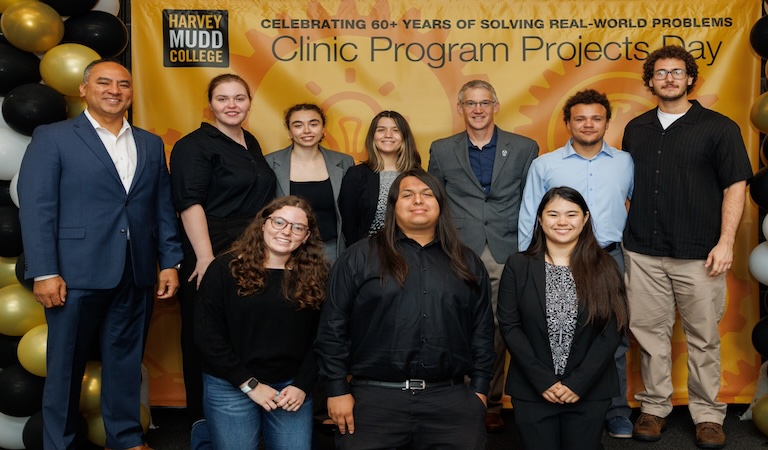Clinic Team’s Barium Titanate Findings Published in MRS Communications
October 22, 2025
A Harvey Mudd College Clinic team has advanced the scientific community’s understanding of barium titanate (BaTiO3 or BTO), an energy storage material that could significantly impact capacitors used in a wide range of applications—power grids, electric vehicles, piezoelectric energy storage and electronic devices. Their research, published on Oct. 1 in MRS Communications, focuses on the flexible materials made from silicone (PDMS) mixed with tiny particles of BTO.
The relationship between BTO particle size, filler-matrix interactions and the properties of BTO-PDMS nanocomposites haven’t historically been completely understood. The multi-disciplinary research team, led by advisor Albert Dato, professor of engineering and associate director of the Engineering Clinic Program, discovered that the phenomenon could be due to a decline in the dielectric constant of BTO at smaller particle sizes and filler—matrix interactions that deform the structure of BTO. Experiments and computer simulations suggest this happens because the smallest BTO particles lose some of their natural ability to hold electric charge, and because of how they interact with and change shape inside the surrounding silicone material.
The impetus for the team’s research was a Clinic project, “Permittivity of Ferroelectric Nanoparticles in a Silicone Composite,” initiated by Sandia National Laboratories. The national lab sponsored the Clinic team’s research into barium titanate, widely used in electronics and energy storage due to its ferroelectric properties. The team of Brigitte Lynch Johnson ’25 (physics), Vanessa Bartling ’26 (engineering), Kayla Long ’26 (engineering), Miranda Brandt ’26 (engineering), Ian Smith ’26 (engineering), Luis Lorenzana ’26 (engineering), Natalie Smith ’26 (engineering), Ian Osborne ’26 (engineering) and Warren Pham ’26 (engineering) fabricated the nanocomposites to measure how the properties change with nanoparticle size and performed density functional theory simulations to understand how the silicone molecules bind to the surface of a barium titanate particle.
“They sought to uncover the fundamental science behind these materials,” says Dato. “Our initial vision was that this knowledge would eventually guide the design of advanced capacitors for Department of Energy applications, such as grid storage and electric buses. However, writing and publishing our recent paper helped us realize that the potential of silicone-matrix nanocomposites containing barium titanate extends far beyond those original goals.”
Silicone filled with barium titanate is an active area of research in the scientific community. These flexible, durable materials can store electrical energy, generate electricity from mechanical motion and even sense changes in pressure, vibration or movement, making them promising candidates for next-generation clean energy and smart-material technologies. They can enable lightweight, flexible power sources and sensors for aerospace systems, wearable and self-powered medical devices and soft robotic components. Because they combine the elasticity of silicone with the remarkable dielectric, piezoelectric and sensing properties of barium titanate, they can be engineered into stretchable, shape-conforming devices that harvest, store and detect energy wherever it is needed.
“The team’s research represents an intersection of materials science, physics and engineering design and highlights how undergraduate research can drive innovation with real-world impact on the future of sustainable technology,” says Dato. “By combining creative experimental approaches with advanced modeling, the students uncovered new insights that could guide the design of next-generation energy storage, sensing and energy harvesting devices.”
In addition to the published study, the students presented their findings at the following national scientific conferences:
- April 7–11, Materials Research Society Spring 2025 Meeting, Seattle, Washington. “Examining Surface Interactions at the Filler-Matrix Interface in Silicone-Matrix Nanocomposites Containing Barium Titanate Nanoparticles for Energy Devices.”
- March 23–27, American Chemical Society Spring 2025 Meeting, San Diego, California. “Investigating Structure-Properties Relationships in Polymer-Matrix Nanocomposites Containing Barium Titanate Nanoparticles” and “Simulating Surface Interactions at the Filler–Matrix Interface in Silicone–Matrix Nanocomposites Containing Barium Titanate Nanoparticles.”
- March 16–21, 2025 American Physical Society Global Physics Summit, Anaheim, California. “Exploring Structure-Properties Relationships in Polymer-Matrix Nanocomposites Containing Barium Titanate Nanoparticles” and “Simulating Surface Interactions at the Filler-Matrix Interface in Silicone-Matrix Nanocomposites Containing Barium Titanate Nanoparticles.”
